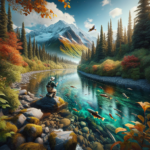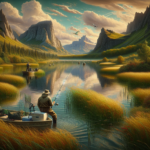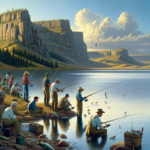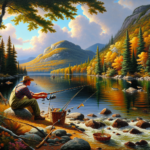Fishing in Connecticut: Inland and Coastal Opportunities
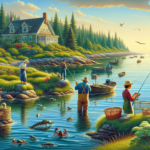
Introduction
Did you know that Connecticut offers some of the most diverse fishing opportunities in the United States, both inland and along its picturesque coastline? Whether you’re an experienced angler or a novice looking to cast your first line, Connecticut has something to offer. This article will explore the rich fishing opportunities available in Connecticut, covering everything from the best fishing spots and techniques to species information and seasonal considerations.
Fishing in Connecticut matters because it provides not only a recreational activity but also a way to connect with nature, contribute to conservation efforts, and even participate in local events and tournaments. Whether you’re looking to find the best fishing spots, master a new technique, or prepare for an upcoming event, this guide has you covered.
Background/Context
Historical or Cultural Significance
Fishing has been an integral part of Connecticut’s history and culture for centuries. Native American tribes, such as the Pequot and Mohegan, relied on the state’s rivers and coastline for sustenance. Today, fishing remains a popular pastime and a vital part of the local economy, with numerous fishing charters, bait shops, and annual tournaments.
Geographical Overview
Connecticut is located in the northeastern United States, bordered by Long Island Sound to the south, which provides ample coastal fishing opportunities. Inland, the state is dotted with numerous rivers, lakes, and reservoirs, each offering unique fishing experiences. The climate varies from cold winters to warm summers, affecting the types of fish available and the best times to fish.
Key Points/Details
Fishing Techniques
Technique Overview
Connecticut offers a variety of fishing techniques, including fly fishing, spin fishing, and trolling. Fly fishing is particularly popular in the state’s rivers and streams, while spin fishing and trolling are commonly used in lakes and coastal waters.
When and Where to Use
Fly fishing is best suited for the Farmington River and Housatonic River, especially during the spring and fall when trout are most active. Spin fishing can be effective year-round in lakes like Candlewood Lake and Bantam Lake. Trolling is ideal for coastal waters, particularly during the summer months when striped bass and bluefish are abundant.
Recommended Gear
- Fly Fishing: 9-foot, 5-weight rod, floating line, and a variety of dry flies and nymphs.
- Spin Fishing: Medium-action spinning rod, 6-12 lb test line, and a selection of lures and live bait.
- Trolling: Heavy-action rod, 20-30 lb test line, and trolling lures or live bait rigs.
Species Information
Species Overview
Connecticut’s waters are home to a variety of fish species, including trout, bass, pike, and saltwater species like striped bass and bluefish. Trout are commonly found in the state’s rivers and streams, while bass and pike are prevalent in lakes and reservoirs. Coastal waters offer opportunities to catch striped bass, bluefish, and flounder.
Best Practices
To successfully catch trout, use small, natural-looking flies or live bait like worms. For bass, try using plastic worms, crankbaits, or spinnerbaits. When targeting striped bass, consider using live eels or bunker as bait, and fish during the early morning or late evening for the best results.
Location Information
Top Fishing Spots
- Farmington River: Known for its excellent trout fishing, with several access points and amenities.
- Candlewood Lake: Offers great bass fishing and has multiple boat ramps and picnic areas.
- Long Island Sound: Provides abundant opportunities for saltwater fishing, with numerous charter services available.
Regulations and Licenses
Connecticut requires a fishing license for anyone over the age of 16. Licenses can be purchased online or at local bait shops. Be sure to check the Connecticut Department of Energy and Environmental Protection (DEEP) website for specific regulations, including catch limits and seasonal restrictions.
Seasonal Considerations
Seasonal Variations
Fishing conditions in Connecticut change throughout the year. Spring and fall are ideal for trout fishing, while summer is best for bass and saltwater species. Winter offers opportunities for ice fishing in lakes and reservoirs.
Best Times to Fish
The optimal times to fish vary by species and location. Early morning and late evening are generally the best times for most species. For trout, spring and fall are prime seasons, while summer is ideal for bass and saltwater fishing.
Events and Tournaments
Event Overview
Connecticut hosts several fishing events and tournaments throughout the year, including the annual Connecticut Fishing & Outdoor Show and various bass fishing tournaments on Candlewood Lake.
Preparation Tips
To prepare for a fishing event or tournament, make sure your gear is in good condition, practice your casting techniques, and familiarize yourself with the event rules and regulations. Pre-fishing the location can also give you a competitive edge.
Tips and Best Practices
General Tips
- Always check the weather forecast before heading out.
- Use local bait and lures to increase your chances of success.
- Practice catch and release to help conserve fish populations.
Avoid Common Mistakes
- Not checking local regulations: Always be aware of the rules and regulations for the area you’re fishing in.
- Using the wrong gear: Make sure you have the appropriate gear for the species you’re targeting.
- Ignoring seasonal patterns: Fish behavior changes with the seasons, so adjust your techniques accordingly.
Advanced Techniques
- Fly Fishing: Master the double haul cast to increase your casting distance.
- Spin Fishing: Learn to use a baitcasting reel for more accurate casting.
- Trolling: Use downriggers to control the depth of your lures more precisely.
Gear and Equipment Recommendations
Essential Gear
- Rod and reel appropriate for your chosen technique.
- Fishing line suited to the species you’re targeting.
- A variety of lures and bait.
- Tackle box with essential tools like pliers, line cutters, and a hook remover.
Optional Gear/Upgrades
- Fish finder to locate fish more easily.
- Waders for fly fishing in rivers and streams.
- Portable GPS to navigate larger lakes and coastal waters.
Where to Buy or Rent
Local bait shops like Hillyer’s Tackle Shop in Waterford and online retailers like Bass Pro Shops and Cabela’s offer a wide range of fishing gear. Some locations also offer rental options for boats and specialized equipment.
Safety and Conservation
Safety Tips
- Always wear a life jacket when fishing from a boat.
- Be aware of weather conditions and seek shelter if a storm approaches.
- Use sunscreen and wear protective clothing to prevent sunburn.
Conservation Practices
- Practice catch and release to help maintain fish populations.
- Respect local wildlife and habitats by not littering and following all regulations.
- Participate in local conservation efforts and clean-up events.
Planning Your Trip
Accommodations
There are numerous places to stay near Connecticut’s top fishing spots, including campgrounds, hotels, and vacation rentals. Popular options include the Interlaken Inn near Lake Wononscopomuc and the Saybrook Point Resort & Marina for coastal fishing trips.
Travel Tips
Connecticut is easily accessible by car, with major highways like I-95 and I-84 running through the state. Public transportation options include Amtrak and local bus services. If you’re flying in, Bradley International Airport is the closest major airport.
Additional Activities
Connecticut offers a variety of activities for non-fishing time, including hiking, boating, and visiting historical sites. The Mystic Seaport Museum and Gillette Castle State Park are popular attractions worth exploring.
Frequently Asked Questions (FAQs)
Do I need a fishing license in Connecticut?
Yes, anyone over the age of 16 needs a fishing license to fish in Connecticut. Licenses can be purchased online or at local bait shops.
What are the best times of year to fish in Connecticut?
Spring and fall are ideal for trout fishing, while summer is best for bass and saltwater species. Winter offers opportunities for ice fishing in lakes and reservoirs.
What are some popular fishing spots in Connecticut?
Popular fishing spots include the Farmington River for trout, Candlewood Lake for bass, and Long Island Sound for saltwater species.
What gear do I need for fly fishing in Connecticut?
A 9-foot, 5-weight rod, floating line, and a variety of dry flies and nymphs are recommended for fly fishing in Connecticut’s rivers and streams.
Conclusion
Fishing in Connecticut offers a diverse range of opportunities, from inland rivers and lakes to the coastal waters of Long Island Sound. By understanding the best techniques, species information, and top fishing spots, you can make the most of your fishing experience in this beautiful state. Whether you’re a seasoned angler or a beginner, Connecticut’s fishing opportunities are sure to provide a rewarding and enjoyable experience. So grab your gear, get your license, and head out to explore the rich fishing opportunities that Connecticut has to offer.

